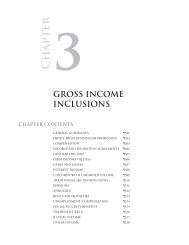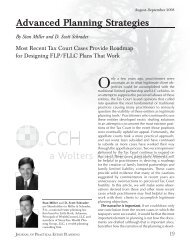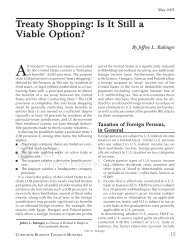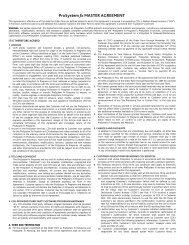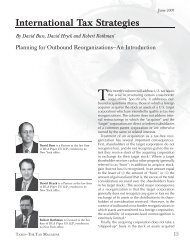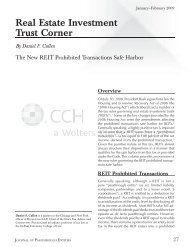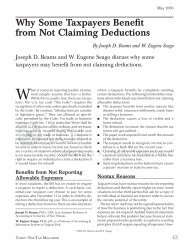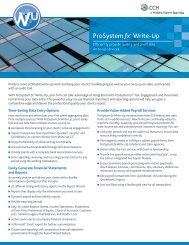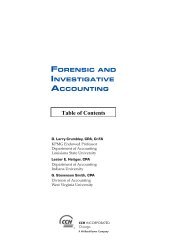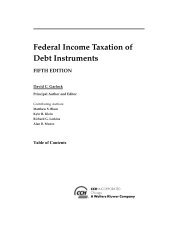The Art of Preparing a Successful Written Protest By William P ... - CCH
The Art of Preparing a Successful Written Protest By William P ... - CCH
The Art of Preparing a Successful Written Protest By William P ... - CCH
Create successful ePaper yourself
Turn your PDF publications into a flip-book with our unique Google optimized e-Paper software.
<strong>The</strong> <strong>Art</strong> <strong>of</strong> <strong>Preparing</strong> a <strong>Successful</strong> <strong>Written</strong> <strong>Protest</strong>Part II: <strong>The</strong> <strong>Art</strong> <strong>of</strong> <strong>Preparing</strong> a<strong>Successful</strong> <strong>Written</strong> <strong>Protest</strong>Is <strong>The</strong>re Official Guidance on Howto Prepare a <strong>Written</strong> <strong>Protest</strong>?<strong>The</strong> IRS provides minimal guidance regarding thepreparation <strong>of</strong> a written protest. Unlike many otherIRS procedures, the IRS does not require the completion<strong>of</strong> a form when filing a protest. <strong>The</strong> regulationsprovide that “instructions for the preparation <strong>of</strong>written protests are sent to the taxpayer with the transmittal(30-day) letter.” 17 <strong>The</strong> current set <strong>of</strong> instructionsincluded with the 30-day letter takes the form <strong>of</strong> IRSPublication 5. 18 <strong>The</strong> instructions include in Publication5 are relatively straightforward and include thefollowing basic requirements:Taxpayer’s name and address, and a daytimetelephone numberA statement that the taxpayer wants to appeal theIRS findings to the Appeals OfficeA copy <strong>of</strong> the letter showing the proposed changesand findings the taxpayer doesn’t agree with(or the date and symbols from the letter)<strong>The</strong> tax periods or years involvedA list <strong>of</strong> the changes that the taxpayer doesn’tagree e with, and why the taxpayer doesn’t agree<strong>The</strong>facts supporting the taxpayer’s position onanyissue that the taxpayer doesn’t agree with<strong>The</strong>elaw or authority, if any, on which the taxpayeris relying<strong>The</strong> taxpayer’s signature on the written protest,stating that it is true, under the penalties <strong>of</strong> perjuryas follows: “Under the penalties <strong>of</strong> perjury,I declare that I examined the facts stated in thisprotest, including any accompanying documents,and, to the best <strong>of</strong> my knowledge and belief, theyare true, correct, and complete.”While the simplicity <strong>of</strong> these instructions is refreshing,particularly when compared with other IRS formsand publications, its brevity leaves taxpayers andrepresentatives with virtually no guidance on theactual preparation <strong>of</strong> a written protest. Consequently,a wide range <strong>of</strong> approaches are available, with noone method trumping the other.<strong>The</strong> remainder <strong>of</strong> this article presents and discusses aset <strong>of</strong> proven techniques for preparing a successful writtenprotest. While recognizing that not all aspects <strong>of</strong> preparinga successful written protest can be covered in onearticle, the five techniques presented in Table 1 shouldbe considered whenever preparing a written <strong>Protest</strong>.40Prepare a Roadmap and RememberThat Presentation Matters 19Don’t spend all your time meeting with the client,gathering facts and conducting legal research. Thisis a mistake many taxpayer representatives makewhen preparing a written <strong>Protest</strong>. Too <strong>of</strong>ten, notenough time is spent on planning and presentation.Let us remember that a 30-day letter imposes a tighttimetable. Good planning is essential. As the sayinggoes, “plan the work; work the plan.” And, asyou plan the work, be sure to leave enough time forwriting (developing an effective presentation). Manyhours dedicated to discovering facts and finding relevantlegal authorities can be obfuscated quickly ifyou don’t have sufficient time to prepare a polishedproduct. Remember, the first impression an AO willhave regarding the representation <strong>of</strong> your client’s caseis your written protest. <strong>Preparing</strong> a polished writtenprotest does not simply happen. It requires goodplanning, organization and writing.Table 1. Five Techniques for <strong>Preparing</strong> a<strong>Successful</strong> <strong>Written</strong> <strong>Protest</strong>Prepare a roadmap and remember thatpresentation mattersFocus on factsDevelop logical and convincing argumentsCritique thereport <strong>of</strong> the examining agentRevise, revise again and revise one more timeA few classic statements about planning and presentation:Matter and manner—we cannot escape them.When they are at one, when what is said has aperfect correspondence with the way <strong>of</strong> sayingit, we have good writing (or speech) on anylevel. But when this law <strong>of</strong> appropriateness isbroken, writing (or speech) becomes in varyingdegrees bad. 20<strong>The</strong> law <strong>of</strong> attention requires that all writingshould reach the comprehension <strong>of</strong> the reader inthe easiest way and with instant clearness. Writingmay be likened to a window through whichthe writer shows the reader a view without. If theglass is poor it will distort the view and irritate





